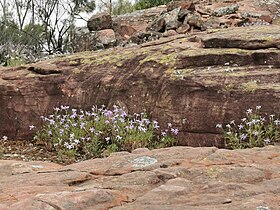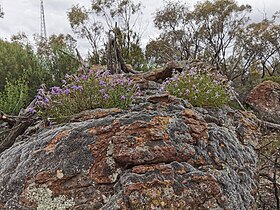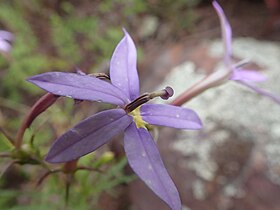
Isotoma is a genus of annual and perennial herbs in the family Campanulaceae and are native to Australia and New Zealand.

Howittia is a genus of plant containing the single species, Howittia trilocularis, commonly known as blue howittia, and is endemic to Australia. It is a tall shrub found growing in shaded valleys and on rainforest edges, it has hairy leaves and single, purple flowers.

Olearia erubescens, commonly known as moth daisy-bush or pink-tip daisy-bush, is a species of flowering plant in the family Asteraceae. It is a shrub with stiff, prickly leaves and white "daisy" flowers, growing up to 2 metres high.

Olearia asterotricha, commonly known as rough daisy-bush, is a species of flowering plant in the family Asteraceae. A tall shrub with white, mauve or blue daisy like flowers growing from the Blue Mountains in New South Wales to western Victoria, Australia.
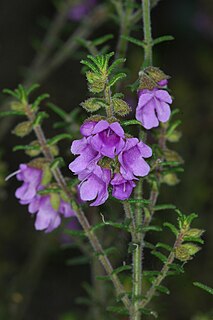
Prostanthera decussata, commonly known as dense mintbush, species of flowering plant that is endemic south-eastern Australia. It is a dense, compact, strongly aromatic shrub with egg-shaped leaves and mauve to violet flowers with yellow streaks, arranged in leaf axils near the ends of branchlets.
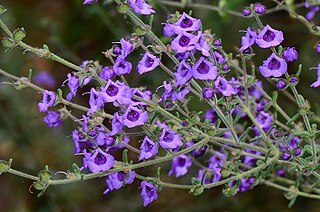
Prostanthera hirtula, commonly known as hairy mintbush, is a species of flowering plant in the family Lamiaceae and is endemic to the south-eastern continental Australia. It is a strongly aromatic, densely hairy, spreading shrub with narrow egg-shaped leaves and dark mauve flowers, and that grows in exposed, rocky sites.
Dasymalla axillaris, commonly known as native foxglove or woolly foxglove, is a flowering plant in the mint family Lamiaceae and is endemic to Western Australia. It is a small, diffuse shrub with its branches, leaves and some of its flower parts densely covered with white, woolly hairs. The flowers are a shade of red and tube-shaped with the stamens and style extending beyond the end of the five petals.

Isotoma fluviatilis, the swamp isotome or blue star creeper, is a small herbaceous perennial plant in the family Campanulaceae, native to Australia.

Isotoma anethifolia is a small herbaceous plant in the family Campanulaceae and is endemic to eastern Australia. It has single, mostly white flowers in the leaf axils and slender stems.
Kunzea axillaris is a flowering plant in the myrtle family, Myrtaceae and is endemic to a small area of New South Wales. It is an erect shrub or tree with linear leaves and white flowers which are arranged singly in leaf axils. It is only known from the ranges on the north coast.
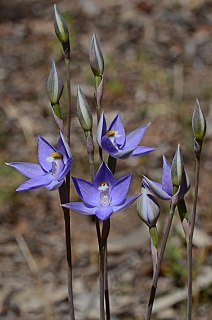
Thelymitra alcockiae, commonly called Kath's sun orchid, is a species of orchid that is endemic to southern continental Australia. It has a single long, narrow leaf and up to twelve pale blue to deep purplish blue flowers, mauve or reddish on their back side.
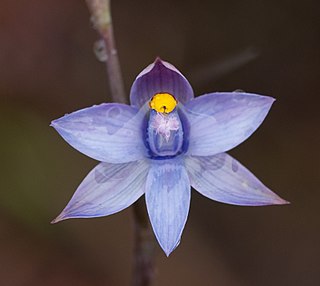
Thelymitra malvina, commonly called the mauve-tufted sun orchid, is a species of orchid that is native to eastern Australia and New Zealand. It has a single large, fleshy leaf and up to twenty five blue to mauve flowers with pink or mauve tufts on top of the anther.

Thelymitra epipactoides, commonly called the metallic sun orchid, is a species of orchid that is endemic to south-eastern continental Australia. It has a single relatively large, leathery leaf and up to twenty large flowers that range in colour from pink to reddish but have a distinctive arrangement of lobes above the anther.
Thelymitra hiemalis, commonly called the winter sun orchid, is a species of orchid that is endemic to Victoria. It is a winter flowering orchid with greenish sepals and blue or mauve petals with large, irregular, darker spots.
Thelymitra atronitida, commonly called the black-hooded orchid, is a species of orchid that is endemic to south-eastern Australia. It has a single erect, leathery, leaf and up to eight moderately dark blue, self-pollinating flowers that only open on hot days.
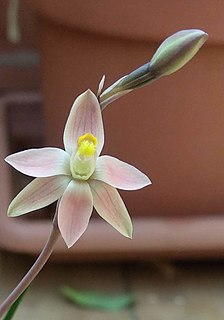
Thelymitra glaucophylla is a species of orchid that is endemic to South Australia. It has a single erect, channelled, pale green leaf and up to fifteen pale blue, mauve or white flowers with an inflated, greyish lobe on top of the anther.

Veronica gracilis is a plant belonging to the family Plantaginaceae, commonly known as slender speedwell. It is a perennial herb with slender branches, variable shaped leaves and small lilac flowers in spring and summer.

Brachyscome dentata, commonly known as lobe-seed daisy, is a tufted perennial herb in the family Asteraceae and is endemic to Australia. It has mostly white or mauve daisy-like flowers, a yellow centre and pale green leaves. It is endemic to Australia.

Prostanthera sejuncta is a flowering plant in the family Lamiaceae and is endemic to a small area of New South Wales. It is a scrambling, more or less prostrate, aromatic shrub with spiny branches, narrow egg-shaped leaves and pale mauve, pale lilac or almost white flowers.

Dampiera rosmarinifolia, commonly known as rosemary dampiera, is a flowering plant in the family Goodeniaceae.It is a perennial subshrub with linear leaves, mauve or purple flowers borne in leaf axils.



